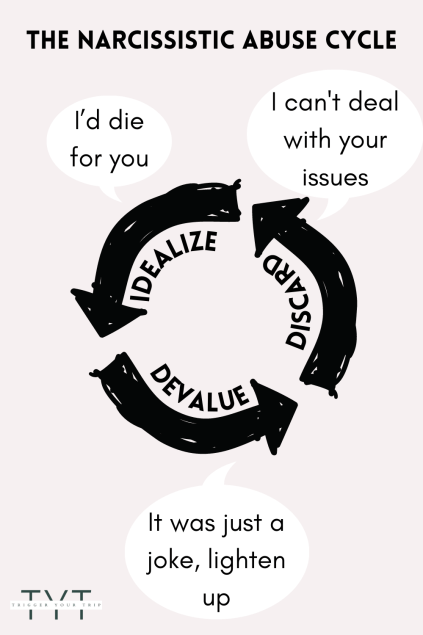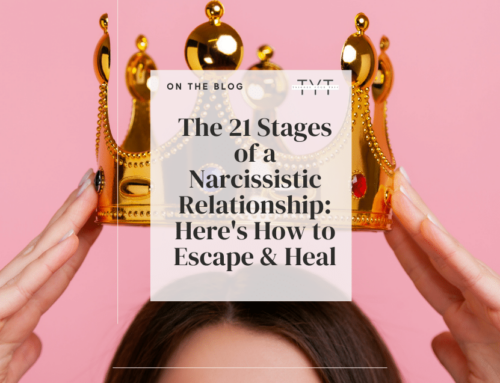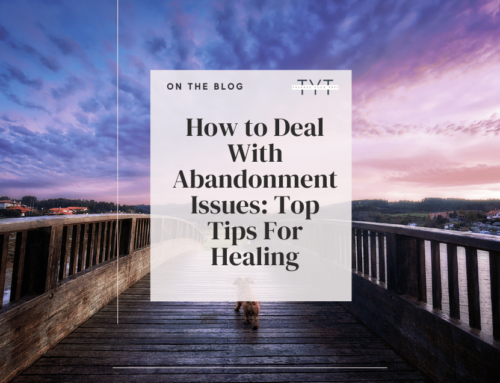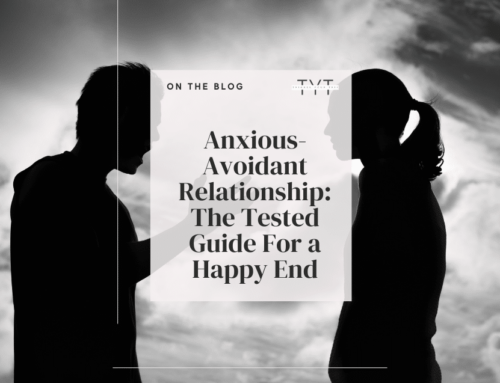Imagine waking up daily feeling trapped, confused, and unsure of how to break free from a relationship that leaves you drained and abused. This is the reality for many who have fallen into the trap of trauma bonding, a tricky and often deceptive form of emotional attachment that occurs when someone repeatedly causes us harm – but we find ourselves unable to break free. You may have experienced this in a toxic relationship or have a friend or loved one struggling to leave an abusive partner.
Regardless of your connection to the issue, the 7 stages of trauma bonding are crucial for anyone seeking to navigate this complex and often painful dynamic. So, if you’re ready to shed light on this issue and take the first step toward healing, you’re in the right place. This article gives you insight, empowerment, and a renewed sense of hope. Let’s dive in.
Striving to Interact More Healthily?
Trauma Bonding – Why Can’t You Leave?
Trauma bonding is a destructive attachment that can’t easily break and occurs in an abusive relationship. It occurs when trauma and intense emotions create feelings of closeness between the victim and the abuser. Along with this intense emotional connection with their victims, the abuser manipulates them with fear, shame, guilt, and love. This bond can be hard to break, as it creates an unhealthy cycle of abuse that keeps victims stuck in dangerous relationships.
Trauma bonds are commonly found in relationships where one partner has power and control over another. People with trauma bonds may have experienced trauma-related symptoms such as PTSD, anxiety, depression, or dependency issues.
People experiencing trauma bonding usually have an insecure attachment style, while they lack healthy boundaries and self-esteem, which makes them codependent and form unhealthy attachments with others. They can be highly vulnerable to manipulation by abusers since they often put their needs behind those of the abuser.
Victims of trauma bonding might stay in this repeated cycle due to feelings of loyalty and responsibility towards the abuser, even if they know the relationship is unhealthy for them. The worst part is they often resist help from trusted people or mental health professionals, as they believe they are “destined” to be with that person, and third parties can’t comprehend it.
Do you have difficulty choosing a mental health professional? Can’t afford in-person couples or individual therapy?
This online therapy toolbox is more efficient and affordable than any other virtual therapy I’ve tried, including BetterHelp and Talkspace. It instantly matches you with a therapist and saves you hours of research for the right one (with unlimited daily messaging and support from your therapist). By leveraging the power of CBT (Cognitive Behavioral Therapy) -the most common psychotherapeutic approach for treating mental health problems- your therapist will guide you to a happier self through weekly sections, CBT worksheets, unlimited messaging, and daily worksheet replies. Bonus price for the fact that you can do your sessions wherever you are in the world and message your therapist anytime, daily.
Related: Reactive Abuse & Narcissism: What Is It & How To Deal With It
Where Does Trauma Boding Occur and What Are The Effects?
Trauma bonding can occur in any relationship but is particularly common in romantic relationships. The dynamics of trauma bonding often involve the abuser showering their victim with attention, love, affection, and gifts in the early stages before switching back to verbal abuse and manipulation. The dynamic creates a cycle where the victim who lacks self-esteem feels dependent on their abuser for validation and love, even if it comes at a cost.
The effects of trauma bonding can be long-lasting and damaging for both parties involved. Victims can experience trauma-related symptoms such as depression or anxiety due to staying in such an emotionally destructive relationship for so long. People must recognize the stages of trauma bonding. When they happen, they can work to find healthier ways to cope with dysfunctional situations rather than creating toxic relationships based on trauma bonds.
Try to recall any abusive behavior, emotional trauma, trauma dumping, or repeated cycles of psychological manipulation before reading the rest of this article. This will give you a greater insight into the experiences mentioned below.
To understand trauma bonding better, it helps to know the 7 stages of trauma bonding. By exploring these seven stages more deeply, we can begin to recognize a trauma bond for what it is – cycles of abuse – and work towards breaking it for good.
Related: Narcissist Gaslighting: 19 Ways to Spot This Dangerous Abuse
What Is a Trauma Bonding Cycle?
A trauma bonding cycle is when someone has an unhealthy relationship with another person, often due to trauma. The trauma bond can make them feel close to the other person even when they are treated badly.
The “cycle” part of this trauma bonding definition means they may stay in the relationship longer than they want to without realizing it. Because they are scared or think it is their responsibility due to the trauma bond they share, they can’t break this cycle.
This can be very damaging for both people involved, and it’s crucial to recognize trauma bonding so we can break free from the cycles of an abusive relationship and emotional addiction.
Related: Why Do I Attract Narcissists? 7 Main Reasons & How to Stop it
Do Narcissists Feel Trauma Bonds?
Yes, narcissists can feel trauma bonds with others. This can be highly destructive to both people involved in the relationship, and it’s not easy for either of them to recognize trauma bonding. Narcissistic abuse, like trauma bonding patterns, occurs subconsciously, so they can’t easily break free from the cycles of an abusive relationship and emotional addiction.
On the one hand, in a narcissist trauma bond, the narcissist feels powerful as they get an outlet to regulate their misinterpreted feelings and trauma. At the same time, a facade of a healthy bond is maintained even though it is pretty clear that it is a trauma-bonded relationship. Thus the narcissist feels dependent and in control while the other person’s emotions are in distress due to the extreme manipulation that results from the trauma and narcissistic abuse.
Another drawback is when narcissists realize they maintain an unhealthy relationship with someone only attached to it based on a traumatic bond and not because they admire or look up to them. In that case, they are likely to feel horrified and lash out.
Related: 12 Traits of a Narcissist To Spot Immediately & Avoid Attachment
How Do I Know If I Am In a Trauma-Bonded Relationship?
Signs that you might be in a trauma-bonding relationship include the following:
-
It feels like a drug addiction.
The trauma bond created by the abuser has strong effects, such as addictive and obsessive behavior, a feeling of being ‘high’ or ‘in love’ when with the abuser, and a need to be around them, even despite any physical or emotional harm caused by them. Like any substance abuse treatment, chances are you’ll need professional help to break the traumatic bonding.
-
You know you’re in a toxic relationship (but you are addicted.)
Victims may become overly dependent on the abuser for emotional validation, leading to an emotional bond and addiction that can be difficult to break without outside help, an objective perspective, and support.
-
You’re mistaking addiction for love.
This can lead to further trauma, emotional damage, helplessness, and disappointment when breaking free from the trauma bond.
-
You find yourself in abusive relationships often.
Victims of trauma bonding can often find themselves in an abusive relationship pattern more frequently, as any act that yields disapproval is met with emotional or psychological abuse.
-
The abusive person escorts to physical abuse (besides psychological abuse.)
When other abusive behavior does not work for the abuser, he/she may resort to domestic violence. Physical violence must be met strongly and firmly with boundaries and distancing.
-
The abuser manipulates you into doubting your perception and sense of self.
Gaslighting might make you believe their theories and distort your memories. When you doubt yourself more often than before, please take it as a sign.
-
You know you can’t please them no matter what, so you give up.
If you feel like everything you do is met with disapproval and can’t seem to do anything right, that is also a huge sign.
-
You make excuses for their behavior.
If your friends and relatives are asking about your abuser’s behavior and you are defending them, then this is also a sign.
-
You distance yourself from close people trying to help.
If you feel like your unique old relationships are gone and have invested a lot in your current abusive relationship, then that’s also a big sign you must let go of the trauma bond.
-
You keep the trauma and abuse a secret.
If you are unwilling to share the ups and downs of your relationship, it means there is something more going on, and you are conveniently blind-sighted. This subconscious act is a significant indicator of a traumatic bond.
-
You’re obsessed with the “good old days.”
If you want to return to the time they showered you with gifts, love, and affection, this is a clear sign of stage 1 of the trauma bond. This obsession is a clear indicator of your toxic relationship.
Read more: 9 Glaring Signs a Narcissist Is Done With You (& How to Heal)
What Are The 7 Stages Of Trauma Bonding?
1) Stage 1: Love bombing.
Love bombing is one of the early stages of trauma bonding and involves your [partner showering you with attention, love, affection, and gifts. It can appeal to some people, especially when they lack self-esteem, making them feel appreciated and necessary. However, the love bombing stage of trauma bonding is also a form of manipulation. The abuser, consciously or unconsciously, uses these tactics to control and make you dependent on them for validation.
Love bombing may happen in a burst where you feel like you are the most important person to the abuser; however, when you are emotionally exhausted in the relationship, you cling to the love bombing stage memories, feeling like your relationship can return to how it was. This is only the case when both partners have agreed to fix their issues through psychotherapy and to work on themselves.
2) Stage 2: You are hooked, and you show trust.
The second stage involves feeling hooked to the relationship and the so-called “abuser”.
In this stage, the connection feels deep, and the trauma bond takes hold of you while you begin to develop feelings of dependency on the abuser. Your partner might continue to shower you with attention and kind words, making you feel loved and appreciated while slowly and subtly manipulating your thoughts and feelings.
The abuser will use the safe space created in the relationship to unleash their traumatic thoughts so you feel trapped in the trauma bond and forced to reciprocate feelings of concern and worry.
Related: How to Let Go of Someone you Almost Had? (The Best Strategies)
3) Stage 3: Devaluing and feeling invalidation in the form of criticism.
The trauma bond is becoming more potent, and you are increasingly dependent on the abuser.
In this stage, the abuser begins devaluing you through criticism and invalidating you. This can be done through verbal abuse or other manipulation that will make you question their worth and feelings.
It’s important to recognize this stage, and often, when people look back at this time, they usually have blurred thoughts and feelings. Because of the gaslighting, you are bound to believe what was said. It takes time and effort to break those thoughts and validate your feelings about what happened.
Related: Am I Being Gaslighted Quiz: The Best Free Quiz To Find Out
4) Stage 4: Emotional abuse, like manipulation and gaslighting.
In the fourth stage of trauma bonding, emotional abuse such as manipulation and gaslighting become increasingly common. This abuse can further control you and make you feel dependent on your abuser. In this stage, the abuser will use subtle tactics such as playing mind games, distorting reality with lies or exaggerations, and making you question your sanity.
Related: How to Expose a Gaslighter: The 9 Smartest Ways
5) Stage 5: You submit and give up
In this stage, you may begin to feel completely powerless and helpless. The abuser has successfully manipulated you and created an environment where you depend on them for your emotional well-being.
At this point, you might give up and submit to your abuser’s will, even if it means sacrificing your values or a sense of purpose.
6) Stage 6: You lose yourself in the abusive relationship
You may feel like you have completely lost yourself in poor treatment at this stage. The abuser has been able to control you and make you feel helpless, resulting in submitting to the abuser’s will or desires without question.
You may feel emotionally suffocated and unable to express your emotions or needs as you fear your partner may neglect you.
7) Stage 7: You get emotionally addicted to the trauma bond
In the seventh and final stage of trauma bonding, you may become emotionally addicted to the bond. Their abuser has thoroughly manipulated you and you are now so dependent on them that you can’t see your life without them.
The abuser has created a highly toxic environment where you cannot express yourselves or get out of the relationship. Once you become highly dependent, you ignore your career, friends, and other relationships, and you almost become a slave to the other person’s approvals and disapprovals.
Read more: 5 Weird Things Covert Narcissists Do & Ways to Protect Yourself
So, How Do You Detach From a Trauma Bond?
Breaking any relationship with an abusive partner starts with:
- Taking a step back and evaluating the situation objectively.
- Practicing self-care and focusing on rebuilding your sense of self.
- Developing healthy boundaries.
- Taking time to reflect and address the trauma.
- Recognizing the triggers that lead you into these 7 stages of trauma bonding.
- Finding the strength to make changes in your life.
- Getting support from friends and family who understand what you’re going through.
- Seeking help from a mental health professional to talk about traumatic experiences.
With these tools in place, the process of detaching from trauma bonds can begin.
Read more: Dismissive Avoidant Attachment: The Push & Pull That Destroys
Final thoughts
It’s essential to recognize the 7 stages of trauma bonding for what it is. It’s an unhealthy form of attachment that can be highly damaging and should not be ignored.
If you or someone you know is in an abusive relationship, seek professional support to guide these seven stages and get you started on the healing journey with open and logical discussion. With the right help, the trauma bonding stage can be broken, your brain chemistry will be altered, and a healthier, more fulfilling life can be achieved.








